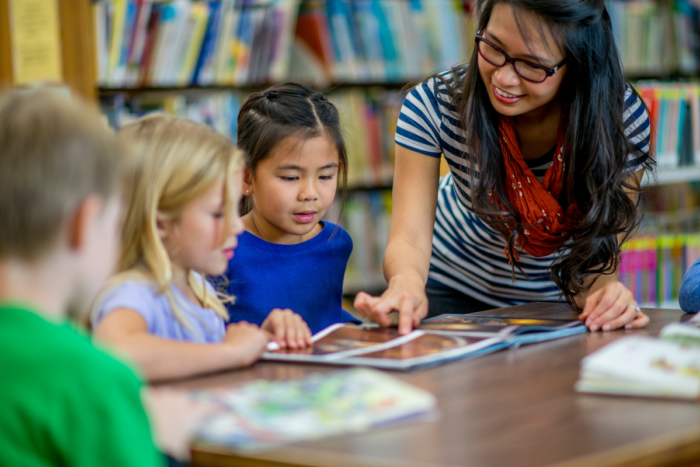
Back to School: Revisiting Empowering Educators
This guest post was written by Haley Brown, a First Book marketing and Communications Intern. She is currently an undergraduate student at The George Washington University in Washington, D.C.
At First Book, we believe that to achieve educational equity, we must approach learning through a fact-based and truthful evaluation of our country’s history. Having a full understanding of the past ensures that the children we educate children will lead us into a healthy, compassionate, and empathetic future. Our Empowering Educators series seeks to equip educators with the tools to have productive, inclusive, and age-appropriate conversations about race with students through an anti-bias, antiracist (ABAR) lens.
Race is an important conversation to have with students in the classroom, especially since many minorities do not feel reflected in the literature around them at school. According to the Children’s Cooperative Book Center, out of 3,415 children’s books received from publishers around the world and reviewed in 2021, only 13% featured Black/African characters; slightly over 10% featured Asian-Pacific Islander characters; slightly more than 7% featured Latine characters; slightly more than 2% featured Indigenous characters; and less than 1% featured Arab characters. With this lack of representation, it’s important to get students involved in the conversation.
Here are our top five takeaways from the full series. Download individual guides or the entire series on our website, free for our Network educators serving children in need.

1. Evaluate Yourself
It is especially important for educators hoping to teach about race to examine their unconsciously held biases. Unconscious bias occurs when we unintentionally allow our own attitudes, feelings, stereotypes, or beliefs to impact our understanding of others — and it can be especially harmful in a classroom environment. Whether our actions and decisions are deliberate or not, the impact on our students is the same.
Only after recognizing that we all hold unconscious biases can we work to actively change our thinking and overcome them. Take our Implicit Association Tests to reveal unconscious bias in a variety of areas, then read our Unconscious Bias Self-Assessment to learn how to restructure your thinking process to avoid bias. While exploring our own implicit bias may be uncomfortable, it is necessary to create a more equitable classroom.
2. Promote Awareness
Educators need to help students become aware of lived experiences that may be different to their own. By preparing engaging and thoughtful lesson plans, educators can teach students about race, anti-racism, and injustice. These lessons should always be taught in an established safe space; remind students of classroom guidelines like listening, confidentiality, and respect.
At different grade levels, students will have a different levels of knowledge about race and race-related events in the news, so it is important to find out what students know and help them decipher between media fact, fiction, and opinion. Need help with lesson plan ideas to thoroughly cover these difficult topics? Download our Teaching Strategies and Lesson plans guide!
3. Help Students Understand
Promoting awareness of different communities is essential to help students recognize and appreciate diversity; however, teaching should not stop at awareness. Students also need help understanding the historical truth behind the division of communities and the different cultural practices and traditions that shape us. With understanding comes respect which leads to a brighter future for all. Refresh your own understanding of American history and social identity through our Guidebook on Race and Racism to better educate students.
For stories to help students of all ages understand different communities, check out our Stories For All Project™ to help your bookshelf reflect the diversity in your classroom.
4. Facilitate Conversation
After teaching students about race and racism, educators need to facilitate productive, insightful, and healthy conversations that allow students to share their own lived experiences. Educators are an essential part of leading a conversation and can use our guide on Challenging Conversations About Race and Racism to successfully navigate these discussions.
Instructors should have boundaries, conversation starters, and questions ready to move discussions further and encourage respectful disagreement. The more prepared you are, the smoother the conversation will run, and the more students will learn!
5. Encourage Reflection
Students should be encouraged to reflect on the topics they are learning about and conversations they have had to further their understanding. Remember that these topics may be sensitive for some students, and they may not want to share their feelings through group conversation. The option to draw or write about their thoughts and experiences should always be offered as a reflection opportunity.
For older students, moments of silence are great reflective strategies that allow students to think deeply. Anonymous feedback should also always be an option for students who may not feel comfortable sharing concerns or critiquing classmates. Further reflection is the key to students’ better understanding of these difficult topics and appreciation of the diversity in their classroom.
Join Our Network
Ready to learn more about employing ABAR teaching techniques in your classroom? Educators can join First Book’s Network — the largest and fastest-growing network of educators, schools, and programs serving children in need across the United States and Canada — to bring new resources and supplies to the classroom.
